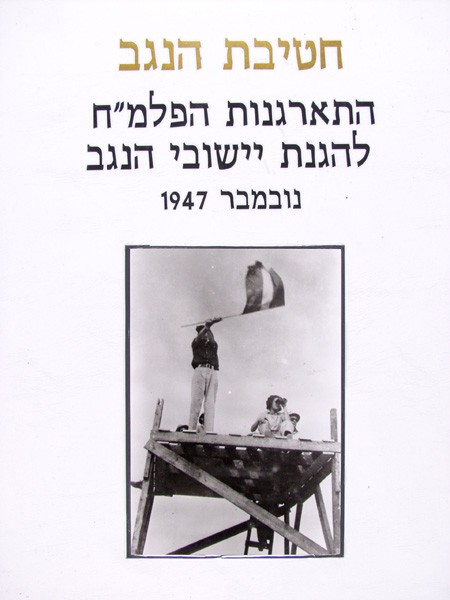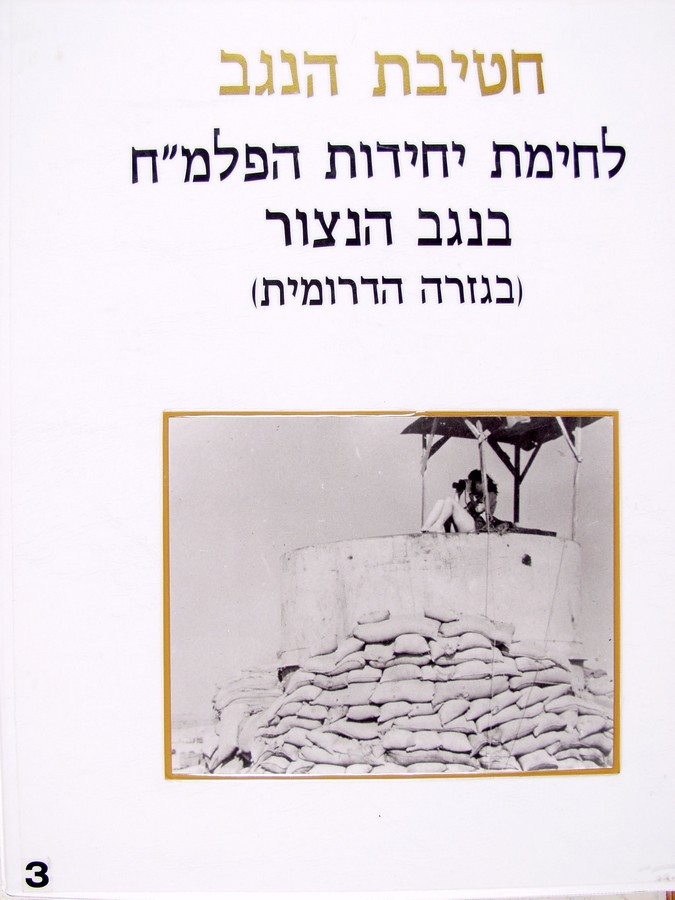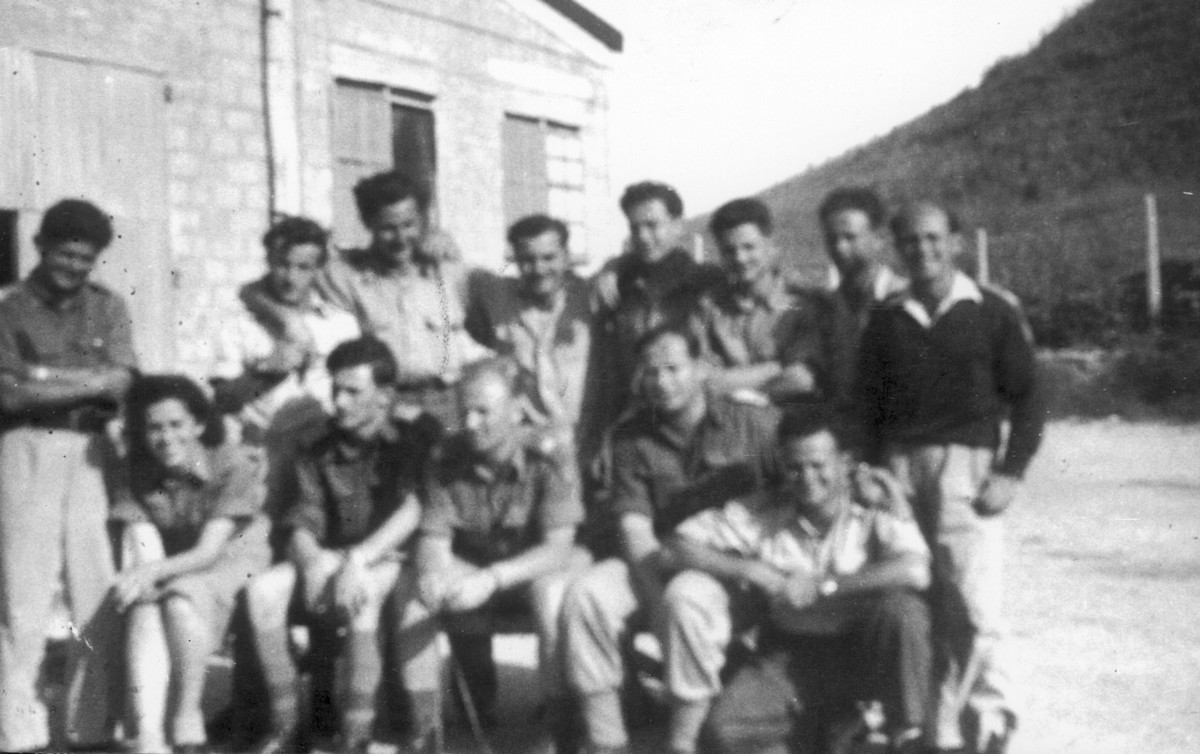The Palmach and the Negev
The sparse population, scattered over the broad expanses of the Negev, the absence of a force (the 'Hagana') to secure the areas between the small settlement points and the total dependence for their daily existence on water and supplies from the north, was the cause of mobilizing the Palmach for the duties of protection and security of the Negev Settlements. At the beginning, the Palmach sent a small company that was gradually reinforced to the size of a battalion.
The Negev Brigade - 9
The Negev Brigade - 4
The Negev Brigade - 1
The Negev Brigade - 10
The Negev Brigade - 2
The Negev Brigade - 5
The Negev Brigade - 6
The Negev Brigade - 7
The Negev Brigade - 8
The Negev Brigade - 3
The Negev Brigade - 11
Iftach Brigade - Second Battalion
The Negev Brigade - Second Battalion
At the end of 1947, and before the vote in the UN on the partition of the state, the situation of the 'Hagana' in the Negev was different to its situation in other areas of the country. Apart from 6 kibbutzim with a large and varied population and an agricultural economy, there were 19 small and isolated points of settlement, each with a population of 15 youngsters (boys and girls) whose subsistence was dependent on supplies from the 'north'. The delivery of regular supplies to these settlements was dependent on the transport system from the center of the country. The roads passed through Arab villages and the vehicles were open to attacks. Even when they tried to bypass the Arab villages by traveling on unpaved roads, they could not avoid the Bedouin camps and again they were vulnerable. The water supply to most of the settlements came from the pipeline that was frequently sabotaged.
In addition, there were no 'Hagana' Security Garrisons (חיל מישמר), like in other districts, that could reinforce the settlements in emergency situations. Also, there were no 'Hagana' field corps that could operate in the district in an emergency. Therefore, it was essential to control the Negev area in another way and on September 1947, the 'Hagana' General Staff appointed the Palmach to undertake the security responsibilities of the Negev.
The Palmach headquarters immediately rallied to the assignment. In October 1947, one company proceeded to the Negev and in January 1948, a battalion headquarters was built under the command of Nahum Sarig. The area was divided into two sectors and the force was divided into two battalions with the 2nd Battalion under the command of Moshe Netzer and the 8th Battalion under the command of Haim Bar Lev. The battalions were small in number, the areas were vast and the assignments were arduous. Most of the tasks were in guarding the pipeline, escorting convoys from the 'north' to the Negev, escorting convoys within the Negev area for the purpose of delivering supplies and reinforcement materials for the settlements. Sometimes they also initiated attacks connected to the defense of the transport on the roads and the pipeline.
The only form of transportation for people and supplies between the 'North' and the Negev was by means of convoys escorted by the Palmach. The dependence of the settlements on the Palmach units and the dependence of the Palmach on the settlements where they lodged, together with overall feelings of existential danger, created a high degree of unity between the settlement population and the Negev Battalions and they became a united fighting force.
The 'Negev Committee' that was formed in the 'North', recruited resources for supplies and daily needs in addition to the requirements for the Palmach units and the defense of the kibbutzim and all the outposts in the Negev.
When the Egyptian expeditionary force invaded on the 15th of May 1948, the situation worsened. The Shaar Hanegev settlements, the headquarters of the Negev Brigade, and the landing strip that had been prepared for the Negev Squadron, were all heavily bombarded. The Palmach H.Q. and the squadron were forced to move eastwards and the women and children were evacuated.
Within a week to ten days, reinforcements for the Brigade arrived. The Palmach H.Q. hastily organized the 7th Battalion and sent it to the Negev. The General Staff sent a combat unit that was made up of 2 companies of jeeps. They immediately began a series of offensive operations in the sector of the Givati Brigade (on the advancing Egyptian forces) and in the Negev Brigade sector. The operations failed on the tactical level but on the strategic level, these operations succeeded in arresting the Egyptian forces in their advance northwards to the center of the country.
On the 10th of June 1948 a ceasefire came into force. One day earlier, the Egyptian army had captured a segment along the length of the Majdal – Bet Jubrin road and separated the Givati Brigade forces from the Negev Brigade forces. A siege was laid on the Negev. However, patrols from the Negev Brigade succeeded in infiltrating convoys of Negev inhabitants and soldiers, by foot. But a series of operations – "Anfar", "Death to the Invader" and "G.I.S. 1" - intended to conquer the segment separating the two Brigades, failed. Also, attempts in operations "G.I.S.2" and "Laderech" (on the way) to break through the siege and infiltrate with supply convoys, were unsuccessful. In the end they overcame the lack of supplies by means of the "Avak" (Dust) operation where the air force landed tons of supplies in hundreds of landings on the emergency landing-strip next to Ruhama.
At the end of August 1948, after 10 months of fighting, the Negev Brigade was relieved by the Yiftah Brigade. The Yiftah Brigade consolidated its hold on the essential areas for protecting the landing-strip. At the same time, the Negev Brigade that was reorganizing in Be'er Yaakov, allowed its fighters to rest while, at the same time, new immigrants from the Shoah who had arrived from the British detention camps in Cyprus, were being trained as reinforcements.
At the beginning of September 1948, a Southern Front Command was established. Beginning in October 1948 until March 1949, in a series of large campaigns, the Egyptian forces were defeated, the Arab legion was driven back and the entire Negev as far as the Red Sea, was conquered.
The Palmach played a dominant role in these campaigns, alongside other brigades of the Israeli army:
The 'Yoav' campaign - the Palmach Negev and Yiftah Brigades.
The ''Lot' campaign – the Palmach Negev Brigade.
The 'Horev' campaign – the Palmach Har'el and Negev Brigades.
The 'Ovda' campaign – the Palmach Negev Brigade which was the last campaign of the 1948 Israeli War of Independence.
In addition, there were no 'Hagana' Security Garrisons (חיל מישמר), like in other districts, that could reinforce the settlements in emergency situations. Also, there were no 'Hagana' field corps that could operate in the district in an emergency. Therefore, it was essential to control the Negev area in another way and on September 1947, the 'Hagana' General Staff appointed the Palmach to undertake the security responsibilities of the Negev.
The Palmach headquarters immediately rallied to the assignment. In October 1947, one company proceeded to the Negev and in January 1948, a battalion headquarters was built under the command of Nahum Sarig. The area was divided into two sectors and the force was divided into two battalions with the 2nd Battalion under the command of Moshe Netzer and the 8th Battalion under the command of Haim Bar Lev. The battalions were small in number, the areas were vast and the assignments were arduous. Most of the tasks were in guarding the pipeline, escorting convoys from the 'north' to the Negev, escorting convoys within the Negev area for the purpose of delivering supplies and reinforcement materials for the settlements. Sometimes they also initiated attacks connected to the defense of the transport on the roads and the pipeline.
The only form of transportation for people and supplies between the 'North' and the Negev was by means of convoys escorted by the Palmach. The dependence of the settlements on the Palmach units and the dependence of the Palmach on the settlements where they lodged, together with overall feelings of existential danger, created a high degree of unity between the settlement population and the Negev Battalions and they became a united fighting force.
The 'Negev Committee' that was formed in the 'North', recruited resources for supplies and daily needs in addition to the requirements for the Palmach units and the defense of the kibbutzim and all the outposts in the Negev.
When the Egyptian expeditionary force invaded on the 15th of May 1948, the situation worsened. The Shaar Hanegev settlements, the headquarters of the Negev Brigade, and the landing strip that had been prepared for the Negev Squadron, were all heavily bombarded. The Palmach H.Q. and the squadron were forced to move eastwards and the women and children were evacuated.
Within a week to ten days, reinforcements for the Brigade arrived. The Palmach H.Q. hastily organized the 7th Battalion and sent it to the Negev. The General Staff sent a combat unit that was made up of 2 companies of jeeps. They immediately began a series of offensive operations in the sector of the Givati Brigade (on the advancing Egyptian forces) and in the Negev Brigade sector. The operations failed on the tactical level but on the strategic level, these operations succeeded in arresting the Egyptian forces in their advance northwards to the center of the country.
On the 10th of June 1948 a ceasefire came into force. One day earlier, the Egyptian army had captured a segment along the length of the Majdal – Bet Jubrin road and separated the Givati Brigade forces from the Negev Brigade forces. A siege was laid on the Negev. However, patrols from the Negev Brigade succeeded in infiltrating convoys of Negev inhabitants and soldiers, by foot. But a series of operations – "Anfar", "Death to the Invader" and "G.I.S. 1" - intended to conquer the segment separating the two Brigades, failed. Also, attempts in operations "G.I.S.2" and "Laderech" (on the way) to break through the siege and infiltrate with supply convoys, were unsuccessful. In the end they overcame the lack of supplies by means of the "Avak" (Dust) operation where the air force landed tons of supplies in hundreds of landings on the emergency landing-strip next to Ruhama.
At the end of August 1948, after 10 months of fighting, the Negev Brigade was relieved by the Yiftah Brigade. The Yiftah Brigade consolidated its hold on the essential areas for protecting the landing-strip. At the same time, the Negev Brigade that was reorganizing in Be'er Yaakov, allowed its fighters to rest while, at the same time, new immigrants from the Shoah who had arrived from the British detention camps in Cyprus, were being trained as reinforcements.
At the beginning of September 1948, a Southern Front Command was established. Beginning in October 1948 until March 1949, in a series of large campaigns, the Egyptian forces were defeated, the Arab legion was driven back and the entire Negev as far as the Red Sea, was conquered.
The Palmach played a dominant role in these campaigns, alongside other brigades of the Israeli army:
The 'Yoav' campaign - the Palmach Negev and Yiftah Brigades.
The ''Lot' campaign – the Palmach Negev Brigade.
The 'Horev' campaign – the Palmach Har'el and Negev Brigades.
The 'Ovda' campaign – the Palmach Negev Brigade which was the last campaign of the 1948 Israeli War of Independence.















